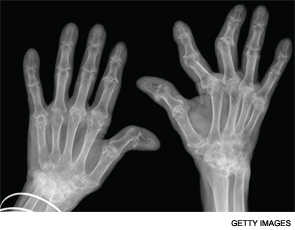
BOSTON—Evaluation of 36 years of data from the Nurses’ Health Study has demonstrated an increased mortality risk for women with rheumatoid arthritis. Results of that and four other trials were presented during the Rheumatology Research Foundation Corporate Roundtable Awards Plenary Session on Nov. 16 at the ACR/ARHP Annual Meeting.
Jeffrey Sparks, MD, MMSC, Brigham and Women’s Hospital in Boston, presented results of the trial (Abstract 818) that evaluated 36 years of follow-up data available from the Nurses’ Health Study (NHS), a cohort of 121,700 women followed from 1976–2012. Medical records and cause of death for 964 women who were diagnosed with incident RA after the start of the NHS were examined and compared with similar data for women in the NHS who did not have RA.
Dr. Sparks reported that the women with RA had a statistically significant 41% increased risk of death from all causes, compared with women without RA, even after adjustment for age and other mortality risk factors, such as cigarette smoking. The risk was 51% higher for women with seropositive RA, when compared with women without RA. For every five years of RA duration, there was an 11% increased risk of death compared with the risk for women without RA.
The risk of respiratory mortality, including chronic obstructive pulmonary disease (COPD), pneumonia, chronic interstitial lung disease and asthma, was “most marked” for women with RA, Dr. Sparks said. There was a twofold increased risk of respiratory death, but the risk was nearly threefold higher among women with seropositive RA compared with women who did not have RA. Dr. Sparks said that COPD was the largest contributor to respiratory deaths among this population, with 25 deaths due to that cause, followed by nine deaths due to pneumonia. “Respiratory causes of death are an underappreciated contributor to RA mortality,” he said.
The risk for cardiovascular disease mortality was also higher at 45%. There was no association between RA and cancer mortality, he said.
Treat to Target
Patients with RA whose disease was tightly controlled for 10 years had a comparable survival rate to people matched by age and gender to people without RA in the general Dutch population. I.M. Markusse, MD, at the Leiden University Medical Center, The Netherlands, reported results of the BeSt study (Abstract 817), which enrolled 508 patients with recent-onset active RA.
Patients with RA were randomized to four treatment arms: The sequential monotherapy and step-up therapy arms started with methotrexate and then switched to or added other therapies; the other two arms started with initial combination therapy that included methotrexate and either sulfasalazine plus prednisone, or methotrexate and infliximab. The combination therapies could be tapered to monotherapy if there was sufficient clinical response. All patients were treated to target over the 10 years, with the goal of a DAS score of 2.4 or lower. The average age of patients was 54; about two-thirds were women and one-third were smokers. There were 72 deaths within the RA population during the study years.
Dr. Markusse reported that there was no increased mortality in RA patients compared with the general population, and that the risk factors for increased mortality, such as age, male gender, smoking and functional disability, are known risk factors in the general population. “Survival in this study can be associated with disease suppression as the result of treat-to-target strategy,” she said.
Some attendees at the presentation questioned the trial design, suggesting that with only 72 reported deaths, the study lacked sufficient power. Another attendee noted that patients with risk factors had been excluded from the RA group, whereas patients with risk factors had not been excluded from the general population comparison group.
Ankylosing Spondylitis Therapy
Dominque L. Baeten, MD, PhD, reported results of a Phase 3 trial (Abstract 819) that evaluated secukinumab, an anti-IL-17A monoclonal antibody biologic drug. Dr. Baeten, of the Academic Medical Centre/University of Amsterdam, said the trial demonstrated that secukinumab “provides rapid, significant, and sustained improvement in the signs and symptoms of active AS and is the first anti-IL-17A monoclonal antibody to demonstrate efficacy in Phase 3 clinical trials in ankylosing spondylitis [AS].”
The 371 patients in the trial, who had AS for an average of 6.5 to 8.3 years, were randomized to three treatment arms: intravenous (IV) secukinumab in 10 mg/kg doses at Weeks 0, 2 and 4, followed by subcutaneous secukinumab at 75 mg doses every four weeks; the same as the first arm except for 150 mg doses of secukinumab instead of 75 mg doses; or placebo on the same IV and subcutaneous schedule. Twenty-seven percent of the patients had had an inadequate response to anti-TNF agents prior to inclusion in the trial.
At Week 1, Dr. Baeten said, there was a statistically significant response in the treatment groups, showing the rapid onset of action, with significant improvements in ASAS40, hsCRP, ASAS5/6 and BASDAI. Treated patients had a significantly higher ASAS20 response at Week 16 with both treatment protocols. The improvements were sustained through 52 weeks.
Dr. Baeten said the clinical benefits “were observed both in patients who were anti-TNF naive and patients who had not previously responded” and that there were no important safety concerns with the treatment.”
New Antigen in RA Complex
Jeremy Sokolove, MD, the VA Palo Alto Healthcare System and Stanford University, Calif., presented results of research (Abstract 815) that found histone citrullination increases innate immunostimulatory capacity and immune complexes containing citrullinated histones activate macrophage cytokine production.
Anticitrullinated protein antibodies (ACPAs) are characteristic to RA, Dr. Sokolove said, but their presence years before the onset of clinical RA has been perplexing. Even though multiple putative citrullinated antigens have been identified, including citrullinated products of NETosis, no studies have previously demonstrated their capacity to initiate RA.
Over 90% of RA patients have anti-cH2B antibodies and over half have measurable levels of synovial fluid H2B immune complexes. Dr. Sokolove said the research demonstrated that autoimmunity to cH2B is arthritogenic, both by primary immunization and immune serum transfer, but only in the setting of underlying low-grade articular inflammation.
“Our findings suggest that intra-articular histone citrullination can link innate immunity via NETosis and adaptive immunity via generation of citrullinated histone immune complexes.” Generation of citrullinated histone antigens during low-grade articular inflammation provides a potential mechanism for conversion from asymptomatic ACPA seropositivity to clinical RA, he concluded.
New Periodic Fever Syndrome
Angeliki Giannelou, MD, the National Institute for Arthritis and Musculoskeletal and Skin Diseases in Bethesda, Md., reported on research (Abstract 816) that used whole exome sequencing and candidate gene screening to examine an unexplained autoinflammatory disease. The research identified a new periodic fever syndrome that is caused by missense mutations in an essential and ubiquitously expressed gene, the TRNT1 on chromosome 3.
The gene mutations were found in children from unrelated families with different ancestries. The five children had recurrent episodes of high fevers with negative sepsis work-up that included an association with microcytic anemia and a spectrum of multisystem features. The accompanying neurologic involvement ranged from mild developmental delay to nystagmus, hypotonia, optic nerve atrophy, and sensorineural hearing loss. Other manifestations included dysmorphic features, musculoskeletal and gastrointestinal symptoms, B cell immunodeficiency and hypogammaglobulinemia.
The research, Dr. Giannelou said, should allow for “further understanding of the mechanisms underlying inflammation.”
Kathy L. Holliman, MEd, is a medical writer based in Beverly, Mass.



